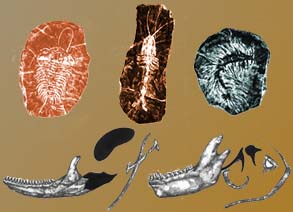 | 

 |  |  |
Module Introduction
In this module we will examine the challenge that the fossil record makes to evolution. Dr. Gish presents the predictions proposed by the evolutionary module and the creation model. He then examines the discoveries found in the fossil record. This allows us to evaluate which model best fits the fossil record. 
| |
Key Points (Learning Objectives)
- Predictions of the fossil record
- Evolutionary model
- Transitional forms
(there should be billions of transitional forms) - Creation model
- Abrupt appearance of fully formed plants and animals
- Variation within kind; no ancestors, no intermediates
 - Evidence from the fossil record
- How circular reasoning is involved in evolutionary geology
- Cambrian rocks
- Billions of fossils are found of complex invertebrates in Cambrian rock
- No ancestor of invertebrates is found in Pre-Cambrian rock
- Invertebrate to fish
- Over a supposed 100 million years of evolution
- There is not one example of an intermediate between invertebrates and fish
- Fish to amphibian
- "First" amphibian—is fully amphibian—feet, legs, large pelvic bone
- Pelvic bone of fish is small; it does not need to support body weight
- Coelacanths were thought to be the transitional form between fish and amphibians. They were thought to be extinct for 70 million years until found alive in 1938.
- Reptiles—land and marine
- No intermediate forms of land reptiles forming from amphibians
- Marine reptiles—no intermediate forms of reptiles developing paddles
- Reptiles to mammals; land mammals to marine mammals
- Cow to whale; Basilosaur, originally classified as a reptile
- Duck-billed platypus—a mosaic
- Flight
- Insects
- Flying Insects—same as modern
- Non-flying Insects—same as modern
- Many fossils of both, but no intermediate fossils between non-flying and flying insects
- Flying reptiles
- Supposed evolution—gradual elongation of fourth finger by mutation and formation of muscles and membrane
- Intermediate stage never found
- Bat
- Oldest known bat same as modern
- No intermediate stage or ancestor; no change in last "50 million years"
- Birds
- Archaeopteryx had feathers, teeth, claws on wings, long, bony tail
- Archaeopteryx was a bird
- It had the basic form and pattern of the avian wing
- It had feathers identical to the feathers of modern birds
- Feathers are a complicated structure, very different from scales
- Feathers develop differently from scales
- It had a furcula, or wishbone
- Teeth, claws on wings and a long bony tail do not necessitate a reptilian ancestry.
- Some other fossil birds also had teeth
- Species with teeth and species without teeth are found among fish, amphibians, reptiles and mammals
- Some modern birds, such as the ostrich, have claws
- Bird found in a layer that was supposedly 75 million years older than Archaeopteryx yet it is more bird like and less reptile like than Archaeopteryx.
 - What evolutionists say about the fossil record
- Botanist—"to the unprejudiced, the fossil record of plants is in favor of special creation."
- Paleontologist of the British Museum of Natural History—there are no transitional forms
- How frozen mammoths support a post flood rapid Ice Age
- Problems with the Hopeful Monster Theory
- Problems with the following statement, "Different forms of life are found as fossils in the different rock systems. These rock systems represent different ages that are part of the geologic column."
- Anomalies in the geologic column that support a global flood
|
Module Assignments
All scripture references and commentaries are from the Defenders Study Bible.

|

